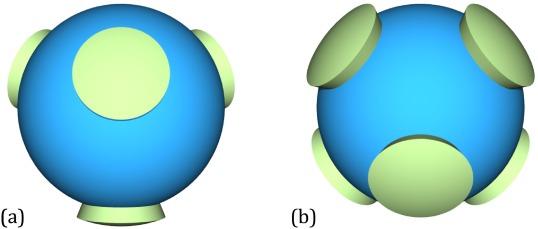A patchy model of the activation of cement
A cement is any of various substances used for bonding or setting to a hard material. A popular one, Portland cement, is a mixture of calcium silicates and aluminates made by heating limestone (CaCO3) with clay (that contains aluminosilicates) in a kiln. The product is then ground to a fine powder. When Portland cement is mixed with water, it sets in a few hours and then hardens over a longer period of time due to the formation of hydrated aluminates and silicates.
The hydration process is, thus, so important that some processes have been developed in order to activate cement, i.e., to enhance the early hydration rate. The hydration phase produces Calcium-Silicate-Hydrate (C-S-H) gel. C-S-H is formed by hydration of alite (tricalcium silicate or C3S) and belite (C2S). It can occupy more than 60% of the total volume of hydration products and has a variable composition. Thus, cement properties (strength, durability…) will depend on C-S-H gel structure and composition.
The structure of C-S-H gel has been a subject of investigation over the last few decades, and significant advancements had being made employing both experimental tools and simulation studies. C-S-H has been found to have a poorly crystalline structure at the molecular level, often considered to be a defective tobermorite-like one.
In simulation studies investigating the structure of C-S-H, two schools of thought can be described. The first approach is to start with a tobermorite structure and to introduce defects to make it consistent with experimental observations. The second is to follow the polymerization reaction of calcium and silica species, without imposing any structural constraints. Now a team of researchers follows this second path, proposing 1 a coarse grained simulation that yields good results for intermediate properties.

The large number of atoms involved in molecular dynamics simulations dramatically increases the computational cost. A simpler model that can reduce that cost, while retaining details of atomistic description is the aim of the researchers. This is why coarse-grained simulation approaches have gained a lot of tractionb in the past few decades, mainly to study complex biological systems such as proteins. In this vein, the so-called patchy-particle-based models have gained a lot of interest, since this approach allows simulating many complex systems using spheres interacting via directional forces.
Previous studies focused on the structure rather than the kinetics. For modelling systems such as C-S-H, where the reaction is mainly kinetically driven, a time-dependent method is needed, more so if the objective is to study the kinetics and the evolution of the structure. Brownian Cluster Dynamics has been previously employed to study colloidal aggregation phenomena leading to sol-gel transition. The patchy version of it, Patchy Brownian Cluster Dynamics (PBCD) is a time-dependent method that can incorporate the effects of solvent without resorting to the explicit representation as in atomistic molecular dynamics simulations.
The researchers use PBCD to model the reversible patchy aggregation of systems containing different amounts of tetrahedral and octahedral patchy particles, a simplified representation of the molecular species Si(OH)4 and Ca(OH)2. By adjusting the model and interaction parameters for a reference system, the model successfully replicated the kinetics and structure evolution of C-S-H gel over a wide range of Ca/Si ratios, and was verified by comparing with various reported atomistic molecular dynamics simulations and experimental results.
The new approach opens up the door to study more complex cementitious systems, such as the reaction between admixtures and cements, using simplified representations. Besides, patchy-particle models seem to have a potential application to study the mesoscale structure of C-S-H, where the nucleation and growth leads to foil like structures and directional growth patterns produce different morphologies.
Author: César Tomé López is a science writer and the editor of Mapping Ignorance
Disclaimer: Parts of this article may have been copied verbatim or almost verbatim from the referenced research paper/s.
References
- Achutha Prabhu, Jorge S. Dolado, Eddie A.B. Koenders, Rafael Zarzuela, María J. Mosquera, Ines Garcia-Lodeiro, María Teresa Blanco-Varela (2022) A patchy particle model for C-S-H formation Cement and Concrete Research doi: 10.1016/j.cemconres.2021.106658 ↩